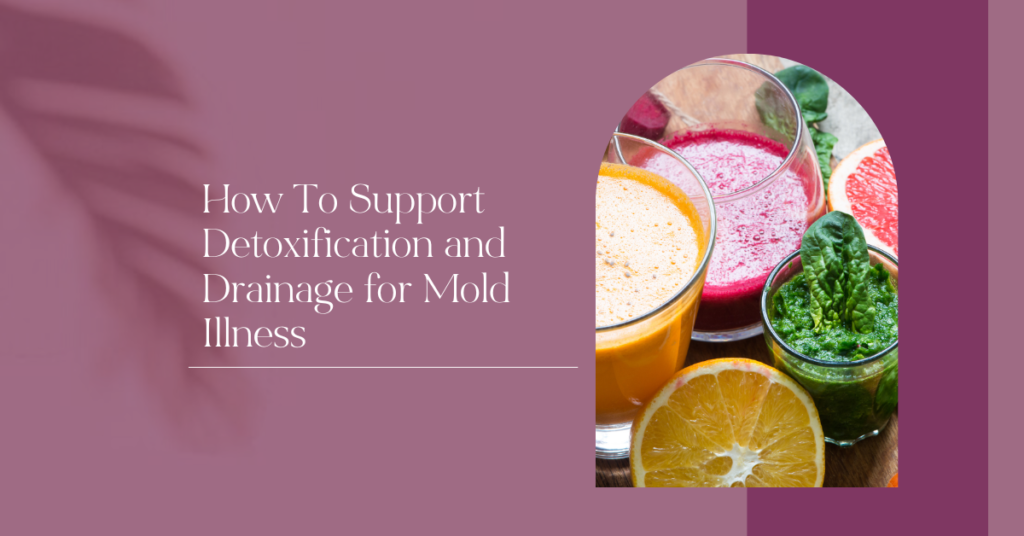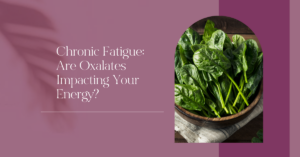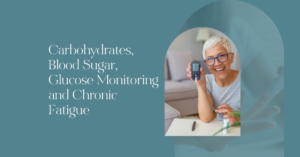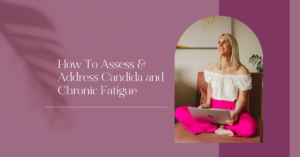Detox and draininage are important concepts to grasp when it comes to recovering from mold illness. This is what you want to know.
What is detoxification?
Detoxification is the biotransformation of substances in the body so that they can be excreted. This work is done by the liver. Once biotransformation has occurred we also need good drainage to actually get the transformed substances out of the body.
What is drainage?
Drainage is the pathway or mechanism by which unwanted substances leave the body. Drainage pathways include:
- Colon: This is the primary drainage pathway. If the body is not eliminating waste via bowel movements, this backs up the entire system and requires the other pathways to pick up its slack. In cases like this, there can be some adverse symptoms along the way.
- Liver and Bile Ducts: The liver processes blood and removes toxins from it, which are then put into the bile. When these get backed up, toxins build up and spill over into the bloodstream. There is then accumulation in the lungs, kidneys, and skin. It can lead to damage to the lining of the lungs and kidneys, as well as itchy/red/irritated skin.
- Skin: It is important to note that skin needs to be an open pathway for drainage via sweat. If a person does not sweat, that is another sign their drainage pathways are compromised.
- Lymphatic System: This drains fluid from the tissues throughout the body, after it has filtered out viruses, bacteria, and toxins. There is also a Glymphatic system, in which the brain drains into the lymphatic system. The Perrin Technique, which is popular in Chronic Fatigue Syndrome, is designed to support the glymphatic system.
We clear toxins from the body in the following order:
Cells > organs and tissues > lymphatic system > Kidneys, Liver and Gallbladder > Colon, Skin and Lungs (drainage pathways)

Therefore, when we consider a comprehensive detoxification support plan there are three factors involved:
- Toxin avoidance, reduce the amount of toxins that are coming into the funnel
- Broaden the funnel from the bottom up (e.g. start with sweating, pooping, urinating and breathing)
- Support the cells; detoxification is an energy demanding process. Therefore healthy cells with healthy mitochondria will detox better.
Colon, Skin and Lungs
The colon, skin, lungs and urinary tract are your drainage pathways. This is how toxins leave your body which means that you want to be peeing, pooping (1-2x per day), sweating and breathing.
This means;
- Drinking enough water; As a rough guide you can take weight (in pounds), divide by 2 to get water in ounces (8oz = 250ml). However, hydration needs may vary depending on size, activity levels and climate but a simple way to check is that when you urinate that your urine is pale yellow in colour.
- Having a bowel movement 1-2x per day
- Oil Pulling for the mouth and a charcoal mouthwash
- Coffee enemas
- Dry brushing for the skin
- Sweating; an infrared sauna for 30-40 minutes 3-4x per week is a great sweat support. If you live in a hot climate or you are able to exercise intensely enough to induce a good sweat response.
- Focus on nasal breathing and use mouth taping at night if you are a known mouth breather.
Although the digestive tract, specifically the colon, is where we eliminate toxins, the digestive tract can also be a source of toxins if we:
- Have dysbiosis or Small Intestinal Bacterial Overgrowth (SIBO)
- Have yeast or fungal infections
- Have elevated levels of beta-glucuronidase which facilitates reabsorption of toxins back into circulation
- Have poor protein digestion due to low levels of hydrochloric acid (which requires thiamine / vitamin B1, zinc and good vagal tone)
This means that part of a comprehensive detoxification support plan requires good digestive health. A comprehensive digestive stool analysis such as the GI Effects by Genova Diagnostics can highlight GI imbalances. If you have any digestive symptoms you want to work to resolve these as part of your detoxification strategy. Sometimes there can be gut imbalances without digestive symptoms, therefore it is always worth considering the gut even if it doesn’t seem like an immediately obvious choice.
The Liver
The liver is where toxins undergo a process of biotransformation. This is where the toxins undergo a series of reactions to prepare them for excretion. This biotransformation process has two phases, phase I and phase II liver detoxification. There are many different enzymes and cofactors that facilitate this process (see diagram). Therefore, all these nutrients are important for detoxification and nutritional deficiencies due to poor diet or digestion and absorption, may impact detoxification.
The stage between phase 1 and 2 detoxification is the intermediary phase. Intermediary stage molecules may actually be more toxic or damaging than the toxins themselves. Therefore, it is important that phase 2 detoxification works just as well as phase 1 detoxification so there is no backlog of intermediary molecules.
Because amino acid conjugation happens in phase 2 detoxification, adequate amino acids and therefore protein consumption, digestion and absorption is going to be important for keeping this phase balanced.
Additionally there should be enough nutrients to offer antioxidant protection for any potential damage created by intermediary molecules.
Liver Supportive Foods
Because so many nutrients are important for optimal liver function there are many different foods that are beneficial for liver health. A good starting point is the basics:
- Eat an organic diet
- Eat good amounts of high quality protein (amino acids are necessary for for detox)
- Consume a varied selection of colourful fruits, vegetables, herbs and spices
- Healthy fats from olive oil, avocado, high quality oily fish, nuts (brazil, almond, pecan) and seeds (pumpkin, hemp and chia).
- Use blood sugar monitoring to make sure blood sugar is stabilised throughout the day
- Allow for periods of rest between meals; ideally observing a 8 hour to 12 hour feeding window with meals 4 to 5 hours apart.
Once these basic foundations have been achieved you can place more focus on adding liver supportive foods such as:
- Ginger
- Milk thistle
- Coriander (cilantro)
- Watercress
- Mint
- Wormwood
- Horseradish
- Sorrel
- Radish
- Peppermint
- Parsley
- Dandelion
- Garlic
- Turmeric
- Citrus
- Organic Liver
- Organic eggs
- Cruciferous vegetables
- Beetroot
- Berries
- Green Tea
My Favourite Supplements for Gall Bladder and Liver Support
My favourite Supplements are:
Gallbladder
The liver makes bile which is then transported to the gallbladder. Here it is held until it is needed for digestion of food. When you eat, your gallbladder releases bile into the bile duct, where it is carried to the upper part of the small intestine (duodenum) to help break down fat in food.
Toxins are carried from the liver to the gallbladder for excretion. Therefore, we can optimise the flow of toxins out of your system by adding nutrients which support bile flow. These include:
- Ginger
- Artichoke
- Dandelion
- Cumin
- Fennel
- Bitter greens like watercress, rocket or endive
Once bile is excreted into the small intestine, soluble fibre will bind the bile and toxins and carry them through the colon until they are excreted in the faeces. Soluble fibre sources include:
- Chia seed
- Hemp seed
- Pumpkin seed
- Flaxseed
Insoluble fibre, found in fruit and vegetables add bulk to stools and help to sweep toxins and bile through the bowels.
Good bile flow is necessary for toxin elimination and it relies on:’
- Healthy liver function
- Healthy gallbladder function
- Bile flow formation
- Bile duct motility
Supporting the liver has already been addressed. A healthy gallbladder is supported by:
- Adequate hydration
- Intermittent fasting
- Stomach acid support
- Foods rich in chlorophyll
- Fibre
- Fermented foods
- Bitter herbs
- Broccoli and kale sprouts
- Supplements such as Tudca
Optimal stomach acid is important for good bile flow and a healthy liver. Stomach acid should be released in the stomach when eating a meal. The acidic bolus of food should travel into the small intestine and this acidity is a trigger for the release of bile. Stomach acid can be low due to stress, nutrient deficiencies, medications (like antacids), eating on the go and drinking too much water with a meal. If you suspect you may have low stomach acid:
- Eat the protein on your plate first to allow for better meat digestion
- Eat mindfully, in a relaxed environment and chew your food properly
- Avoid drinking with meals
- Eat your largest meal when you can be most relaxed
- Use lemon and / or apple cider vinegar with meals
- Supplement with Betaine Hydrochloride
Lymphatic System
The lymphatic system is part of the immune system and complementary to the circulatory system. It is made up of lymphatic vessels, lymph nodes, lymphatic or lymphoid organs, and lymphoid tissues.
Its role is to:
- Remove excess fluids from body tissues. When working well, this prevents a build up of fluid and water retention. Removal of fluids is how the lymphatic system acts as an organ of detoxification and waste removal.
- Absorb fatty acids and transport of fat to the circulatory system.
- Produce immune cells (such as lymphocytes, monocytes, and antibody producing cells called plasma cells).
Lymph fluid drains into lymph capillaries, which are tiny vessels. The fluid is then pushed along when a person breathes or the muscles contract. The lymph capillaries are very thin, and they have many tiny openings that allow gases, water, and nutrients to pass through to the surrounding cells, nourishing them and taking away waste products. Movement and breathing are therefore the two primary ways in which we can encourage removal of cellular waste via the lymphatic system. Moving little and often throughout the day can be beneficial.
Ways to stimulate the lymphatic system:
- Dry brushing
- Lymphatic drainage massage
- Jumping on a rebounder
- Walking, running, swimming or whole body movements
- Gua Sha and other manual lymphatic drainage techniques
- For more information follow @stopchasingpain
Cellular Detox
Autophagy is made up of the words auto (self) and phagy (eating). It refers to the process by which a cell will cannibalize some of its own parts in a continual clean-up process that keeps it functioning in a healthy way. You can think of it as taking out the “cellular trash”. As a result, cell function improves. Healthy cells allow for a healthy functioning body and mind.
Research suggests that defects in autophagy regulation are associated with poor cellular health and disease, including neurodegenerative diseases, cancer, pathogen infection and metabolic diseases.
Upregulating the natural cellular process of autophagy may therefore have benefits in metabolic health, neurodegeneration, energy production, relieving the cellular toxic burden, reducing inflammation and promoting longevity.
Autophagy can be induced when cells sense stress signals such as heat stress (using a sauna), cold stress (cryo-therapy), fasted exercise, resistance training or certain autophagy-boosting foods.
Approaches such as fasting, calorie restriction and the ketogenic diet create nutritional stress which can induce autophagy. All of which are best applied under the supervision of a qualified health professional. You can learn more about these approaches in the blood sugar module.
Cell Membranes
Healthy cells have healthy cell membranes which can control the flow of nutrients in and waste products out.
Cell membranes are essential structures which maintain the integrity and function of each cell in your body. Cell membranes let nutrients into the cells and actively remove waste products out the cell. They help the cell regulate inflammation and, in the context of hormones, they help with communication between cells.
Cell membranes are made primarily of cholesterol, phospholipids and membrane proteins. This means foods which supply cholesterol, phospholipids and choline, are all great for cell membrane health. Cholesterol can be found in eggs and many animal based fats such as shellfish, meat and dairy. Choline can be found in chicken breast, salmon, bone marrow, liver, pork, eggs, beef, shrimp, broccoli and green peas.
There are many types of phospholipids, 3 of which have been identified as important for human cell membrane health.
Phosphatidylcholine is the most abundant phospholipid in the human body. It is the precursor to acetylcholine, a neurotransmitter which is important for cognitive function such as memory.
Phosphatidylserine is important for general cell health, especially in maintaining healthy brain biochemistry. It can be found in meat and fish.
Phosphatidylethanolamine is known for playing a significant role in cellular membrane formation. It is important for the health of neural tissue.
In addition to consuming these cell membrane building foods you want to ensure you limit or avoid foods that would potentially be destructive to your cell membranes. These include; refined sugar, vegetable oils, fried, burnt or blackened foods.
Omega 3 fatty acids, such as those found in oily fish help to maintain cell membrane fluidity. Sometimes I ask my clients to do a red cell fatty acid test which can indicate the balance of omega 3 to omega 6 in cell membranes and can inform dietary changes and personalise omega 3 supplementation.
Colourful plant-based foods offer natural exogenous antioxidants that can protect cell membrane health. These include nutrients and phytonutrients such as vitamin A, C and E, CoQ10, Beta-Carotene, Lycopene and Zeaxanthin (found in paprika).
Summary and Conclusion
As you can probably tell, detox and drainage is a BIG piece of the fatigue recovery puzzle. It can become increasingly complicated when someone is very senstitive, due to heightened toxic load, and there are digestive issues which first need to be resolved.
If you would like support and guidance in your journey, you can find out more about working with me here.









